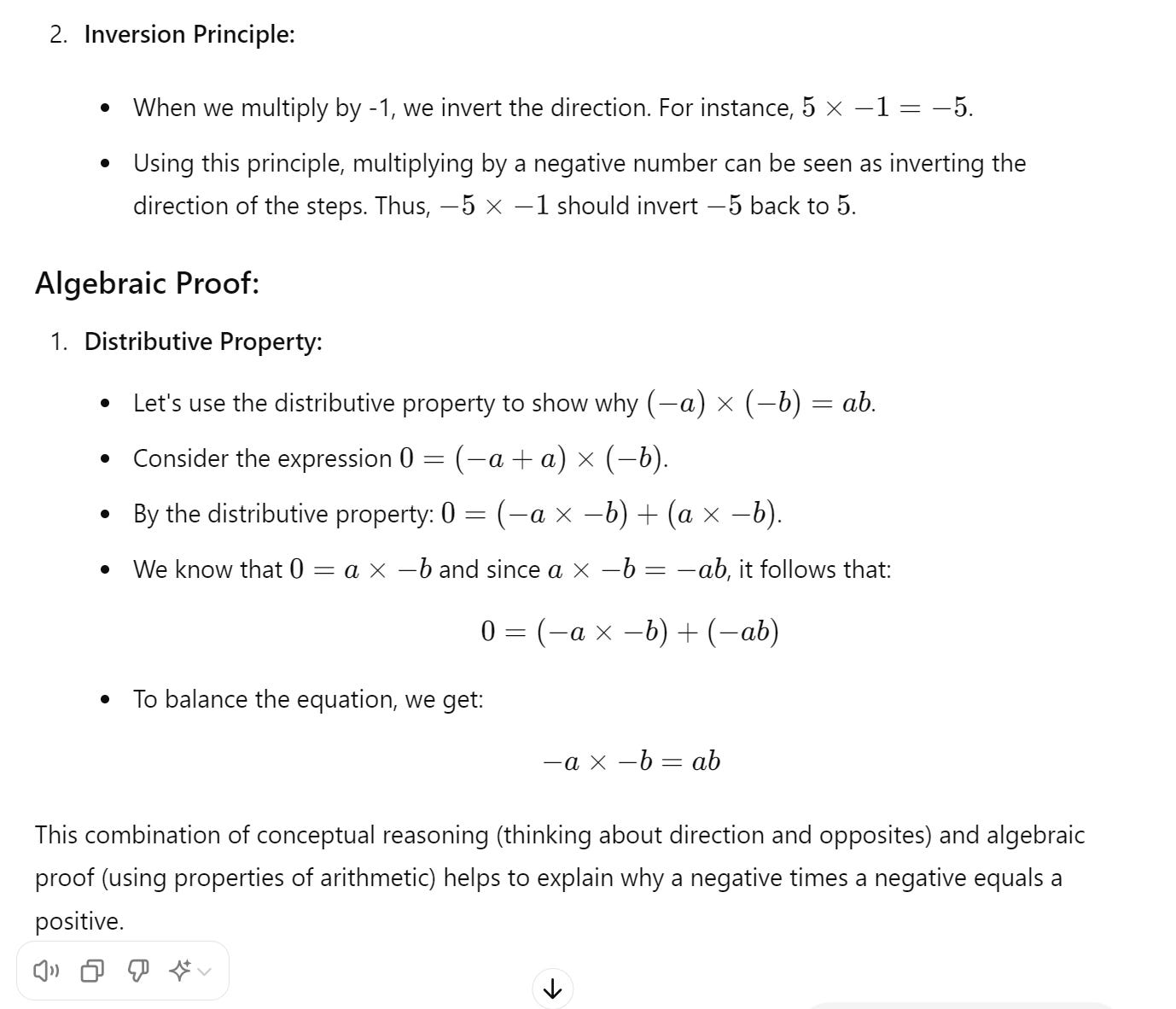Can ChatGPT stand and deliver conceptual understanding?
A failed attempt to use generative AI to help me understand algebra

“A negative times a negative equals a positive.” (Say it!)
“A negative times a negative equals a positive.” (Again!)
“A negative times a negative equals a positive.” (Louder!)
“A NEGATIVE times a NEGATIVE equals a POSITIVE.”
Why?
If you’re over a certain again and love movies about education – and hey, that’s me – perhaps you recognize my reference to a scene from the 1988 classic film Stand and Deliver, starring Edward James Olmos. The movie is based the story of real-life math teacher Jaime Escalante who taught his students AP Calculus at Garfield High School in East Los Angeles, and it’s worth doing some background reading on the arc of his teaching career.
This scene has been on my mind for a couple of reasons. Reason #1: This week, I’m preparing to share insights from cognitive science to the team at Google that’s working on AI in education, and I want to highlight something that many of us know but may struggle to explain. I know that a negative times a negative equals a positive, at least in part because I’ve had Olmos’s classroom incantation running through my head my entire life. But if you ask me to justify this statement, which is to say, if you ask me to explain why it’s true…well, uh, I’m not sure. We’ll come back to my struggles shortly.
Reason #2: By helpful coincidence, I also listened last week to the recent podcast from The Disagreement on the “Math Wars.” (Disclosure: The host Alex Grodd is a good friend.) For 30 minutes, journalist and learning science advocate Holly Korbey spars with Kevin Dykema, president of the National Council of Teachers of Mathematics, over how we should teach math to students. It’s an interesting debate, and among other things they clash over whether students first need to learn basic math facts before they can develop higher level conceptual understanding (Korbey’s view), or vice versa (Dykema).
Reason #3: There’s a wonderful kid in my neighborhood, Jeremiah, who loves to swing by my house at odd hours and ask me to give him math problems to do in his head. He’s good at this, and I take tiny delight in watching him calculate mentally, I swear I can almost see the little mental gears turning in his mind as he does so. Lately, I’ve introduced the idea of multiplying by negatives, accompanied by some light explanation that this involves “going backwards instead of forwards.” But we haven’t touched negatives times negatives because, again, I’m not sure how to explain why this results in a positive number.
See how this ties back to that scene in Stand in Deliver? In one minute of cinematic pedagogy, we see Olmos both “drilling and killing” a fact into his students’ heads, and asking them a question to probe whether they understand it, conceptually. The Korbey-Dykema debate notwithstanding, I’m not convinced the sequencing of this knowledge matters all that much. The goal should be for students to both know the procedural fact (and have memorized it), but also to have some sense of why it’s true.
Ok, so now back to me. For the Googlers and for Jeremiah, I want to some way of conceptually explaining why a negative times a negative equals a positive, and I thought maybe just maybe ChatGPT could help me out. Here’s my first attempt:
Does this help your conceptual understanding of this mathematical rule? It doesn’t me. Not only did ChatGPT fail to offer any sort of example that ties to the real world, I’m still staring at that algebraic proof of the distributive property and going “huh?” And please note how it makes no attempt to figure out what knowledge I’m bringing to the table, and just assumes I’m familiar with various concepts (such as a number line) that I might not have learned yet. Think about how Jeremiah would experience this interaction.
But, prompt engineering matters! So I tried again:
There’s kinda sorta something to this, right? Thinking about negative numbers using money feels a step in the right direction, it ties the abstract math to something I’m familiar with. Owing three people $4, yep that seems like negative $12 dollars to me. But…but…I don’t get how paying them off is conceptually “positive”? Paying off the debt means I have $12 less in my bank account. That doesn’t seem positive, hence my follow-up prompt:
Reader, it did not help clarify things. This is a word salad. This statement from ChatGPT simply does not explain how owing money (negative direction) multiplied by another negative number (owing more money??) leads to a positive number. It’s why I’ve sometimes described chatbot tutors as practicing anti-learning pedagogy when they produce guidance that generate new confusion and misconceptions.
If you think I’m cherry picking, here’s another example:
Again, world salad. This won’t help me explain things to the Google team, or to Jeremiah, or to anyone else for.
But happily our story doesn’t end here. Over the course of my career in education, I’m befriended some extraordinary math teachers, and I suspected if I looked into some of their writings on this topic I might get what I was looking for. And lo, I found this helpful overview from math educator David Wees, who polled some teachers on the negative-times-a-negative idea and shared this comment from one:
Boom! This was the breakthrough, and not just because I happen to play too much poker. Losing $10 per day? Yes, that’s a negative (with respect to money). Going back five days? Yep, that’s negative too (with respect to time). Multiply those two negatives and it means we go back in time to when I had more money – very much a positive. A negative times a negative equals a positive and that’s why.
If you’re still reading, congratulations on wading through all this algebra. And look, I suspect that if I prompted ChatGPT with this question repeatedly, perhaps with more precise prompting, it might occasionally provide a response similar to the one Wees shared. But as my experience shows, many times it will generate output that isn’t helpful – that’s a negative. And I’m going to keep calling attention to this pedagogical limitation even if it makes me sound negative.
Because a negative times a negative equals a positive. Say it!











Nice piece, and I completely agree. I recently did a thorough review of Khan's new book about AI tutoring and reached similar conclusions. Check it out if you like: https://mattspivey.substack.com/p/i-read-this-book-so-you-dont-have
In our book "Traditional Math" we use a similar example, except we don't use money, we use amount of water flowing out of a tank. If the tank loses water at 30 gal/min, (i.e., -30) how much more water was there 3 minutes ago (i.e., -3) -3 x -30 = 90